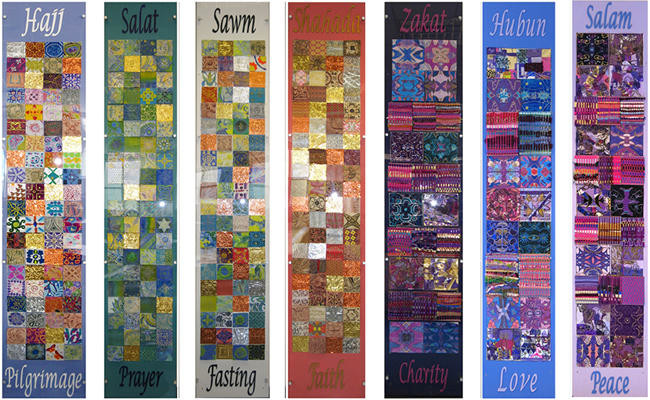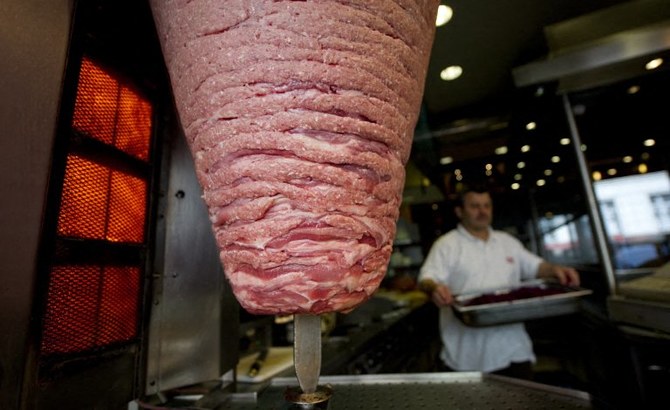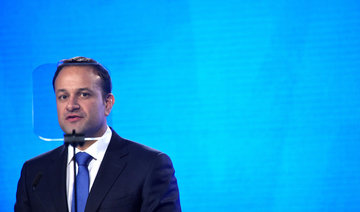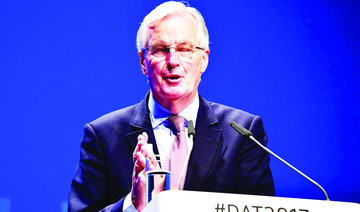LONDON: While many teenagers at UK schools are typically learning how to conjugate French verbs or practicing how to order a cheese sandwich in Spanish, young people in a Northern Irish grammar school are busy perfecting their Arabic calligraphy skills.
For the past year, the Belfast Royal Academy has been trialing Arabic lessons in an effort to encourage students to see the potential benefits of speaking non-European languages for their future careers. All pupils in Year 1 (11-12-year-olds) are required to study Arabic alongside their other subjects.
With the UK’s departure from the EU looming, the need for the next generation to speak languages such as Arabic and Mandarin Chinese could become even more urgent as the country looks to forge closer trade ties with non-EU countries.
The ‘Global Britain’ UK politicians are currently so eager to espouse will need to speak global languages.
“Post-Brexit, they might need languages that they haven’t thought of before,” said Paul Porter, head of modern and classical languages at the Belfast Royal Academy.
Porter led the initial efforts two years ago to obtain funding for the school’s Arabic program from the British Council. A total of nine schools in Northern Ireland won funding last September.
To engage students in the language, Porter said it was important to show them how relevant Arabic could be in running a business.
“We are known for green pastures, butter and potatoes — and we export that and it is bought by people living in places that are not so green — we are trying to show the students that we need those languages to go to that market,” he said.
Government organizations such as InvestNI have also given talks to the students to explain how Arabic can be a useful business tool.
Porter’s comments come after the British Council released a report in early November which drew up a list of what it considered the top five most important languages for the UK’s post-Brexit strategic interests.
Arabic was ranked in fourth place, with Mandarin in second place, alongside French, Spanish and German.
The report said that the UK was at a turning point, recommending that it was time to put into place “a bold new policy to improve foreign language learning for a transformed global Britain”.
It specifically called for UK governments to take a “strategic approach to building capacity in Arabic and Mandarin Chinese.”
Commenting on the report, Vicky Gough, schools adviser at the British Council, said: “It highlights that Arabic is not only one of the 10 most significant languages for international education — in response to economic growth and expanding political influence in a number of countries in the Middle East — but it is a key language for international diplomatic postings.”
While Arabic will have benefits for the UK’s economic future, said Porter, the language has offered far more than that to his students. It has opened them up to a culture that may be quite alien to their day-to-day existence and often misunderstood due some of the “negative connotations” students might see in the media.
“We had to change that. Change the whole mindset so we decided to use calligraphy to change that to show how beautiful the language is,” he said. “The whole school is decorated in Arabic calligraphy.”
He explained that the school opted to teach Arabic through art as well as via its culture and food as a way of engaging and exciting students about a language that can be difficult to learn for those used to Latin-based languages.
“We make it attractive for the children and we sow seeds that it is a beautiful language, a language that people use all over the world,” he said, adding that the school is non-denominational and had no religious or other reasons to teach Arabic apart from the language being “rich, varied and beautiful.”
The achievements at Belfast Royal Academy stand in contrast to the fairly limited teaching of Arabic seen in the rest of the UK. Just five or six percent of English secondary schools teach Arabic, though usually as an extra-curricular subject, according to the British Council report last month.
Arabic is often taught as a language option where a large proportion of the school is considered Muslim, and while Arabic may not be their first language, many of the students might be exposed to it at home or in mosques.
Arabic was first offered as a GCSE option in 1995 with 1,182 entries rising to 4,211 entries by 2016, according to the British Council report.
Research cited by the report suggested the growth in Arabic learning is likely mainly due to the expansion of Muslim faith schools, with few non-Muslim children having the opportunity to learn the language.
The way in which Arabic is taught in the UK needs improving, said Rabab Hamiduddin, teacher of Arabic and a research associate at the School of Oriental and African Studies (SOAS) in London.
She also runs the Arabic Club for Kids which runs Arabic classes on weekends across the UK capital. She said that when she first opened the school in 2007 she found that the Arabic teaching resources available to teachers were inadequate.
“I saw problems in Arabic when I first opened my school. There’s just no ability to rely on academic high-level solutions for literacy. Whereas there are for English and other languages, there definitely aren’t for Arabic.
“The resources fail in terms of providing what children learn from and enjoy. Many children come to our school and... (the parents) said my child used to hate Arabic and now they love it.”
With the need for better resources in mind, Hamiduddin spearheaded a research group that produced The Arabic Club for Kids Guided Reading Scheme, a series of 80 banded guided reading books in Arabic for children.
Sue Bodman, an expert from the international literacy center, Institute of Education at the University of London, also worked on the project.
“It is very effective and very child-centric. Its philosophy is based on how children acquire language. They are very colorful books and have a very strong semiotic value,” she said.
“We think our scheme has made the first step. Teachers want to do things but have nothing to latch on to. They want to inspire but they are dragged down by the resources,” she added.
She is currently working on a proposal to open a new bilingual school in Kensington, London next year to offer bilingual education in both Arabic and English to children aged between three and five years.
To further support the expansion of Arabic in schools, the British Council has recommended that governments and schools draw from the successes of the existing Mandarin Excellence Programme in England and the China strategy in Scotland.
The Mandarin program — which is funded by the government and delivered by the UCL Institute of Education with the British Council — has just started its second year of operation.
It will see 5,000 school pupils in England on track to gain fluency in Mandarin Chinese by 2020, said Katharine Carruthers, director of the UCL Institute of Education (IOE) Confucius Institute.
“What makes the program unique is that, on average, students will study eight hours of Mandarin — including four hours of taught lessons — every week,” she said.
“Feedback from students and teachers has indicated that studying Mandarin for an average of eight hours a week has really allowed them to explore the language in more depth — and pupils can see their own progress much quicker than usual, which appears to be very motivating.”
“Having advanced Mandarin skills will be a great asset for a young person to be able to put on their CV — both now and in the years ahead,” she said.
If the efforts seen in schools in Northern Ireland so far are replicated across the whole of the UK, Arabic language skills could join Mandarin Chinese as another skill young people are able to put on their CV, making themselves stand out in an increasingly competitive global job market.
Why Brexit means Brits should learn Arabic
Why Brexit means Brits should learn Arabic

Meaty issue: German political party calls for €4.90 price cap on doner kebabs

- Die Linke appeals to government as price of national favorite hits €10 in some cities
- Scheme would cost taxpayer about €4bn
LONDON: German political party Die Linke has urged the government to cap the price of a much loved food item — the doner kebab.
The party has proposed providing daily vouchers to households that would limit prices to €4.90 ($5.28) and €2.90 for young people under an initiative known as Donerpreisbremse.
The scheme is projected to cost the government about €4 billion.
Introduced after the Second World War by Turkish immigrants who adapted the dish to suit local tastes, the doner kebab is a national favorite in Germany, with an estimated 1.3 billion consumed annually. But their soaring price has become a hot-button political issue.
Die Linke said the cost of a doner kebab had reached €10 in some cities, from €4 just two years ago.
“For young people right now it is an issue as important as where they will move when they leave home,” said Hanna Steinmuller, a lawmaker with the Greens party.
“I know it’s not an everyday issue for many people here … but I think as voter representatives we are obliged to highlight these different perspectives.”
German Chancellor Olaf Scholz was famously confronted by a voter last year who demanded he “speak with Putin … I’m paying €8 for a doner.”
With public pressure mounting, Scholz recently acknowledged on social media that “everywhere I go, mostly by young people, I get asked if there should be a price cap for doner kebabs.”
Despite the appeals, the chancellor rejected the proposal, citing the impracticality of price controls in a free market economy.
Despite its humble origins as a street food, the doner kebab has become an unexpected point of political focus.
Last month, German President Frank-Walter Steinmeier sparked controversy when on a visit to Turkiye he gifted 60 kg of kebab meat from Berlin to Istanbul in what some called a clumsy attempt to symbolize the strong cultural ties between the two nations.
A 98-year-old in Ukraine walked miles to safety from Russians, with slippers and a cane

- Describing her journey, the nonagenarian said she had fallen twice and was forced to stop to rest at some points, even sleeping along the way before waking up and continuing her journey
KYIV, Ukraine: A 98-year-old woman in Ukraine who escaped Russian-occupied territory by walking almost 10 kilometers (6 miles) alone, wearing a pair of slippers and supported by a cane has been reunited with her family days after they were separated while fleeing to safety.
Lidia Stepanivna Lomikovska and her family decided to leave the frontline town of Ocheretyne, in the eastern Donetsk region, last week after Russian troops entered it and fighting intensified.
Russians have been advancing in the area, pounding Kyiv’s depleted, ammunition-deprived forces with artillery, drones and bombs.
“I woke up surrounded by shooting all around — so scary,” Lomikovska said in a video interview posted by the National Police of Donetsk region.
In the chaos of the departure, Lomikovska became separated from her son and two daughters-in-law, including one, Olha Lomikovska, injured by shrapnel days earlier. The younger family members took to back routes, but Lydia wanted to stay on the main road.
With a cane in one hand and steadying herself using a splintered piece of wood in the other, the pensioner walked all day without food and water to reach Ukrainian lines.
Describing her journey, the nonagenarian said she had fallen twice and was forced to stop to rest at some points, even sleeping along the way before waking up and continuing her journey.
“Once I lost balance and fell into weeds. I fell asleep … a little, and continued walking. And then, for the second time, again, I fell. But then I got up and thought to myself: “I need to keep walking, bit by bit,’” Lomikovska said.
Pavlo Diachenko, acting spokesman for the National Police of Ukraine in the Donetsk region, said Lomikovska was saved when Ukrainian soldiers spotted her walking along the road in the evening. They handed her over to the “White Angels,” a police group that evacuates citizens living on the front line, who then took her to a shelter for evacuees and contacted her relatives.
“I survived that war,’ she said referring to World War II. “I had to go through this war too, and in the end, I am left with nothing.
“That war wasn’t like this one. I saw that war. Not a single house burned down. But now – everything is on fire,” she said to her rescuer.
In the latest twist to the story, the chief executive of one of Ukraine’s largest banks announced on his Telegram channel Tuesday that the bank would purchase a house for the pensioner.
“Monobank will buy Lydia Stepanivna a house and she will surely live in it until the moment when this abomination disappears from our land,” Oleh Horokhovskyi said.
Amazon Purr-rime: Cat accidentally shipped to online retailer

- Galena was found safe by a warehouse worker at an Amazon center after vanishing from her home in Utah
LOS ANGELES: A curious cat that sneaked into an open box was shipped across the United States to an Amazon warehouse after its unknowing owners sealed it inside.
Carrie Clark’s pet, Galena, vanished from her Utah home on April 10, sparking a furious search that involved plastering “missing” posters around the neighborhood.
But a week later, a vet hundreds of miles (kilometers) away in Los Angeles got in touch to say the cat had been discovered in a box — alongside several pairs of boots — by a warehouse worker at an Amazon center.
“I ran to tell my husband that Galena was found and we broke down upon realizing that she must have jumped into an oversized box that we shipped out the previous Wednesday,” Clark told KSL TV in Salt Lake City.
“The box was a ‘try before you buy,’ and filled with steel-toed work boots.”
Clark and her husband jetted to Los Angeles, where they discovered Amazon employee Brandy Hunter had rescued Galena — a little hungry and thirsty after six days in a cardboard box, but otherwise unharmed.
“I could tell she belonged to someone by the way she was behaving,” said Hunter, according to Amazon.
“I took her home that night and went to the vet the next day to have her checked for a microchip, and the rest is history.”
What did people eat before agriculture? New study offers insight

- Analysis of forms — or isotopes — of elements including carbon, nitrogen, zinc, sulfur and strontium in these remains indicated the type and amount of plants and meat they ate
WASHINGTON: The advent of agriculture roughly 11,500 years ago in the Middle East was a milestone for humankind — a revolution in diet and lifestyle that moved beyond the way hunter-gatherers had existed since Homo sapiens arose more than 300,000 years ago in Africa.
While the scarcity of well-preserved human remains from the period preceding this turning point has made the diet of pre-agricultural people a bit of a mystery, new research is now providing insight into this question. Scientists reconstructed the dietary practices of one such culture from North Africa, surprisingly documenting a heavily plant-based diet.
The researchers examined chemical signatures in bones and teeth from the remains of seven people, as well as various isolated teeth, from about 15,000 years ago found in a cave outside the village of Taforalt in northeastern Morocco. The people were part of what is called the Iberomaurusian culture.
Analysis of forms — or isotopes — of elements including carbon, nitrogen, zinc, sulfur and strontium in these remains indicated the type and amount of plants and meat they ate. Found at the site were remains from different edible wild plants including sweet acorns, pine nuts, pistachio, oats and legumes called pulses. The main prey, based on bones discovered at the cave, was a species called Barbary sheep.
“The prevailing notion has been that hunter-gatherers’ diets were primarily composed of animal proteins. However, the evidence from Taforalt demonstrates that plants constituted a big part of the hunter-gatherers’ menu,” said Zineb Moubtahij, a doctoral student in archaeology at the Max Planck Institute for Evolutionary Anthropology in Germany and lead author of the study published on Monday in the journal Nature Ecology & Evolution.
“It is important as it suggests that possibly several populations in the world already started to include substantial amount of plants in their diet” in the period before agriculture was developed, added archeogeochemist and study co-author Klervia Jaouen of the French research agency CNRS.
The Iberomaurusians were hunter-gatherers who inhabited parts of Morocco and Libya from around 25,000 to 11,000 years ago. Evidence indicates the cave served as a living space and burial site.
These people used the cave for significant portions of each year, suggesting a lifestyle more sedentary than simply roaming the landscape searching for resources, the researchers said. They exploited wild plants that ripened at different seasons of the year, while their dental cavities illustrated a reliance on starchy botanical species.
Edible plants may have been stored by the hunter-gatherers year-round to guard against seasonal shortages of prey and ensure a regular food supply, the researchers said.
These people ate only wild plants, the researchers found. The Iberomaurusians never developed agriculture, which came relatively late to North Africa.
“Interestingly, our findings showed minimal evidence of seafood or freshwater food consumption among these ancient groups. Additionally, it seems that these humans may have introduced wild plants into the diets of their infants at an earlier stage than previously believed,” Moubtahij said.
“Specifically, we focused on the transition from breastfeeding to solid foods in infants. Breast milk has a unique isotopic signature, distinct from the isotopic composition of solid foods typically consumed by adults.”
Two infants were among the seven people whose remains were studied. By comparing the chemical composition of an infant’s tooth, formed during the breastfeeding period, with the composition of bone tissue, which reflects the diet shortly before death, the researchers discerned changes in the baby’s diet over time. The evidence indicated the introduction of solid foods at around the age of 12 months, with babies weaned earlier than expected for a pre-agricultural society.
North Africa is a key region for studying Homo sapiens evolution and dispersal out of Africa.
“Understanding why some hunter-gatherer groups transitioned to agriculture while others did not can provide valuable insights into the drivers of agricultural innovation and the factors that influenced human societies’ decisions to adopt new subsistence strategies,” Moubtahij said.
Palestinian prisoner in Israel wins top fiction prize

- The mask in the novel’s title refers to the blue identity card that Nur, an archaeologist living in a refugee camp in Ramallah, finds in the pocket of an old coat belonging to an Israeli
ABU DHABI: Palestinian writer Basim Khandaqji, jailed 20 years ago in Israel, won a prestigious prize for Arabic fiction on Sunday for his novel “A Mask, the Color of the Sky.”
The award of the 2024 International Prize for Arabic Fiction was announced at a ceremony in Abu Dhabi.
The prize was accepted on Khandaqji’s behalf by Rana Idriss, owner of Dar Al-Adab, the book’s Lebanon-based publisher.
Khandaqji was born in the Israeli-occupied West Bank city of Nablus in 1983, and wrote short stories until his arrest in 2004 at the age of 21.
He was convicted and jailed on charges relating to a deadly bombing in Tel Aviv, and completed his university education from inside jail via the Internet.
The mask in the novel’s title refers to the blue identity card that Nur, an archaeologist living in a refugee camp in Ramallah, finds in the pocket of an old coat belonging to an Israeli.
Khandaqji’s book was chosen from 133 works submitted to the competition.
Nabil Suleiman, who chaired the jury, said the novel “dissects a complex, bitter reality of family fragmentation, displacement, genocide, and racism.”
Since being jailed Khandaqji has written poetry collections including “Rituals of the First Time” and “The Breath of a Nocturnal Poem.”
He has also written three earlier novels.






















